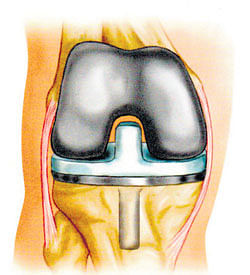Should knee replacement be total or partial?
Dr Biren Nadkarni explains the procedure of partial and total knee replacement

Knee Replacement is done to replace the weight-bearing surfaces of the knee joint to relieve pain and disability on patients suffering from arthritis mainly osteoarthritis where the pain is unbearable.
The knee has three compartments - the medial compartment (inside aspect of the knee), the lateral compartment (outside of the knee) and the patellofemoral compartment (in front of the knee). It is usually the medial compartment that is affected by osteoarthritis. The lateral compartment is affected, but it happens later.
Partial knee replacement or Unicompartmental knee replacement is a surgical procedure used to relieve arthritis in one of the knee compartments which replaces only the affected compartment of the knee in comparison to total knee replacement where there is a need to replace all the three compartments.
The concept of Partial knee replacement was designed to cause less trauma or damage than traditional Total knee replacement by removing less bone and trying to maintain most of the patient’s bone and anatomy. Also, the concept was designed to use smaller implants and thereby keep most of the patient’s bone; this can help patients return to normal function faster.
The Partial knee surgery may be possible if the arthritis in the knee is confined to a limited area. If the arthritis is widespread, then the partial knee replacement is not appropriate, and should not be considered. In addition, the partial knee surgery is recommended in patients who are: Older than 55 years, not obese, relatively sedentary and have intact ligaments.
Benefits and risks associated with partial knee replacement:
* Surgery is done through a 3-inch incision, compared to a 10- to 14-inch incision in Total knee replacement.
* Patients usually have less pain and leave the hospital the day after surgery.
* Healing tends to be much quicker with most patients walking with just a stick and back to their routine activities in just 4 to 6 weeks
* The motion of the knee usually approaches that of a normal knee making bending activities easier.
* Less blood loss
Risks could include a higher rate of revising the partial knee replacement than total knee replacement, potentially worse function after revision of partial knee replacement than total knee replacement and revisions can be more complicated than primary surgeries
The long-term results are very good when the minimally invasive Partial knee replacement is done on the right patients. Older studies showed very poor results of the partial knee replacement, but these results are thought to be due to poor patient selection. If the minimally invasive procedure is done on a patient with too widespread arthritis, the results are very likely to be less than satisfactory.
When patients with a partial knee replacement are properly selected, the minimally invasive procedure is quite successful. That said, some patients continue to develop arthritis in other areas of the knee. Also, some patients wear out the unicompartmental knee implant, or it may come loose within the knee. All of these situations would require additional surgery, and possibly the conversion to a total knee surgery. Conversion from a Partial knee replacement to a total knee can be more difficult because of the prior surgery, but it is not uncommon and results of conversion are good.
(The author is a senior orthopedic and joint replacement surgeon at Sitaram Bhartia Institute of Science and Research)
Deccan Herald is on WhatsApp Channels| Join now for Breaking News & Editor's Picks